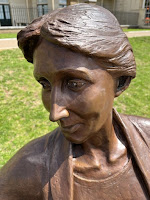Bronze sculpture of Virginia Woolf seated on a riverside bench
in Richmond Upon Thames by Laury Dizengremel (2022)
Photo by Maria Thanassa (2023)|
They made a statue of us
/ And they put it by the riverside / Now tourists come and sit with us
Blow bubbles with their gum / Take photographs of fun, have fun [1]
I.
When plans were first announced to place Laury Dizengremel's sculpture of Virgina Woolf on a bench overlooking the Thames, concerns were raised by members of the Richmond Society who, recalling details of her death [2], feared it was not only insensitive, but also potentially triggering [3].
Richmond Council, however, were not persuaded and supported the siting of the statue, where it would be encountered by far more people than if it were tucked away on a residential street (although whether it encourages discussion of mental health issues, feminism, and sexuality, is debatable).
The £50,000 bronze sculpture was finally unveiled in November 2022. Speaking at the unveiling ceremony, Woolf's great-great niece, Sophie
Partridge, said critics of the project were narrow minded and insisted that Woolf should be celebrated for her work, not defined by the
way she died.
II.
Unfortunately, I wasn't able to attend the above ceremony. However, I finally got to see the work up close and personal this week, when I took the Little Greek on a literary tour of Richmond to celebrate her name day.
It's not bad: certainly better than the barefoot bronze of D. H. Lawrence by Diana Thomson, that stands in the grounds of Nottingham University; or Danny Osborne's reclining Oscar Wilde Memorial Sculpture, in Merrion Square, Dublin.
At any rate, Dizengremel's life-size figure wasn't irritating and didn't immediately make me want to smash it. But neither did it make me want to sit down and take a selfie, which, apparently, is the aim. For Dizengremel believes art should be accessible and encouraging of interaction. And she is keen to make lofty literary figures like Woolf not only relatable, but touchable.
'It is my hope', she says, 'that Virginia will be rubbed raw ...'
I have to say, I imagine that Woolf would have been horrified at the thought of being pawed (one might even say molested) in this manner by members of the public; of becoming public property. Personally, I think people should show more respect, not less, to great figures and learn to keep their hands to themselves.
It would be preferable, in other words, if people remained a little afraid of Virginia Woolf - her intelligence, her demeanour, her sapphic superiority and disdain for the masses and modernity - rather than emboldened by a bronze figure to the point where they sit and put an arm around her shoulders in an act of gross overfamiliarity.
Finally, let me ask those who think this sculpture is a victory for feminism: How is turning a remarkable woman into an object and plaything in this manner challenging stereotypes?
Notes
[1] With apologies to Regina Spektor, whose lyrics to the song 'Us' I have slightly reworked here.
'Us' was a 2006 single release from the studio album Soviet Kitsch (Sire Records, 2004). To listen to the track and watch the official video, dir. Adria Petty, on YouTube, click here.
[2] On 28 March 1941, Woolf, aged 59, drowned herself by filling her coat pockets
with stones and then calmly walking into the River Ouse near her home in
East Sussex.
Woolf had been troubled by mental illness throughout her life; she was institutionalised several times and attempted suicide on at least two other occasions. Some commentators trace this back to the sexual abuse she (allegedly) suffered a the hands of her two much older half-brothers, George and Gerald Duckworth, about which I have recently written: click here.
[3] The group's chairman, Barry May, rather ludicrously suggested that the sculpture 'might distress anyone
who knows her story and is in a vulnerable state of mind'. One suspects he had ulterior motives in opposing the siting of the work by the river; perhaps he suffers from automatonophobia, or perhaps he's just afraid of Virgina Woolf.
.jpg)
